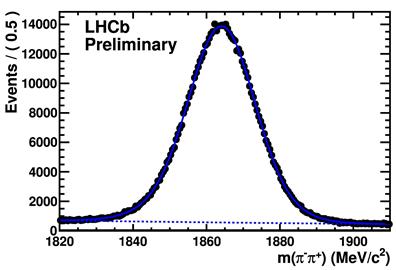[ ΔACP = (-0.82 ± 0.21 ± 0.11)% ]
The LHCb Collaboration has presented today at the Hadron Collider Particle Symposium in Paris possible first evidence for CP violation, the difference between behaviour of matter (particles) and antimatter (antiparticles), in charm decays. The study of CP violation in both charm and beauty particle decays is central to the LHCb physics programme. In the Standard Model CP violation is expected to be very small in the charm sector, whereas new physics effects could generate enhancements.
In this new analysis the LHCb physicists have used data collected in the first half of the 2011 run to study the differences in decay rates of neutral D meson particles composed of a charm quark c bound with an up antiquark (u) and D meson antiparticles (D) composed of a charm antiquark (c) bound with an up quark (u). The decays of D*+ mesons into D mesons and π+, and D*- mesons into D mesons and π– were used to select the D and D mesons. In the next step of the analysis the difference (asymmetry ACP) between the decay rates of D and D mesons into K+K– pairs as well as into π+π– pairs was measured. By determining the difference, ΔACP, in CP asymmetries for the K+K- and π+π– decays, the analysis strongly suppresses possible measurement biases which could arise through effects related to particle production, selection etc. The following preliminary result is obtained:
ΔACP = (-0.82 ± 0.21 (stat.) ± 0.11 (sys.) )% [ 3.5 sigma significance for experts ]
A very interesting period now begins. LHCb physicists are analysing the remainder of the data collected in 2011. If the result is confirmed theoretical work will be required to establish whether this effect can be accommodated in the framework of the Standard Model, or whether a new physics explanation is required.

click the image for higher resolution
The figures show the invariant mass distribution of the K–K+ (around 1.4 million) and π–π+ (around 0.4 million) pairs. The distributions are centered at the D meson mass of 1865 MeV.
Read more in CERN Bulletin article in English and French, in the CERN Courier, in the CERN Quantum Diaries blog in English and French and also in the LHCb staff page.

